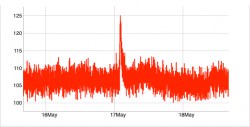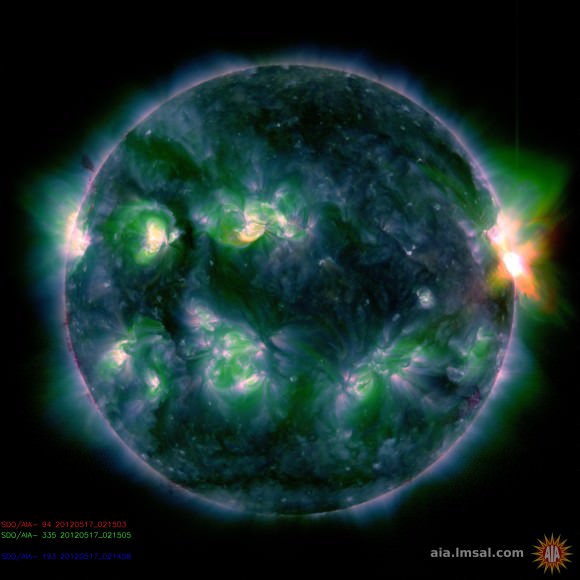[/caption]
When a moderate-sized M-class flare erupted from the Sun on May 17, it sent out a barrage of high-energy solar particles that belied its initial intensity. These particles traveled at nearly the speed of light, crossing the 93 million miles between the Sun and Earth in a mere 20 minutes and impacting our atmosphere, causing cascades of neutrons to reach the ground — a rare event known as a ground level enhancement, or GLE.
The first such event since 2006, the GLE was recorded by a joint Russian/Italian spacecraft called PAMELA and is an indicator that the peak of solar maximum is on the way.
The PAMELA spacecraft — which stands for Payload for Antimatter-Matter Exploration and Light-nuclei Astrophysics — is designed to detect high-energy cosmic rays streaming in from intergalactic space. But on May 17, scientists from NASA’s Goddard Space Flight Center convinced the Russian team in charge of PAMELA to grab data from the solar event occurring much closer to home.

The result: the first observations from space of the solar particles that trigger the neutron storms that make up a GLE. Scientists hope to use the data to learn more about how GLEs are created, and why the May 17 “moderate” solar flare ended up making one.
“Usually we would expect this kind of ground level enhancement from a giant coronal mass ejection or a big X-class flare,” said Georgia de Nolfo, a space scientist at NASA’s Goddard Space Flight Center. “So not only are we really excited that we were able to observe these particularly high energy particles from space, but we also have a scientific puzzle to solve.”
Fewer than 100 GLEs have been recorded in the last 70 years, with the most powerful having occurred on February 23, 1956. Like most energetic solar outbursts, GLEs can have disruptive effects on sensitive electronics in orbit as well as on the ground, and based on recent studies may even have adverse effects on cellular systems and development.

Read more on the NASA news release here.


AFAIK the light from sun reaches earth in 8 minutes, so if it took 20 minutes for these particles to reach earth they would have travelled at less than half the speed of light.
Hence why the article clearly states “nearly” the speed of light and not “at” the speed of light.
no quiero morir!!!!
no quiero morir!!!!
Ah, so the radiation environment at the surface have another contribution. Radioactive minerals & gases (radon), x rays from ground lightning and soft gamma rays from high altitude discharges, cosmic radiation … and now this.
Anyone else associating to neutron bombs (excellent sterilizers, I hear)? =D :{
I think the point Charvel is trying to make is that half of something is not “nearly”. I don’t think there is an international standard for “nearly” but I’m fairly certain that 1 third or something does not approach it.
Would “a considerable fraction thereof” have made my dear readers breathe easier? 😉 Crossing 93 million miles in 20 minutes is still mighty fast, I’d say.
that rare type of solar storm looks wicked scary
By NEARLY we should read “very close to” (as per the Oxford English Dictionary) say at least at 98 per cent of the speed of light. Twenty minutes to travel 93 million miles is “roughly” 1/3 at the speed of light and nowhere near to “almost” 300,000 kms per second.
It seems that this sort of glitch about well confirmed scientific data is hapenning too often in today’s weblogs. Hence so many readers addressing this issue hoping for a higher attention to the details that the authors provide to the internet users and lovers of the astronomy and cosmology fields.
This does leave me scratching my head a bit. The solar induced cosmic rays are traveling about 50% the speed of light. As commented on below this is a bit less than “nearly the speed of light.” The Lorentz gamma factor is ? = 1/sqrt{1 – (v/c)^2}, which for v/c = .5 is ? = 1.15. For a particle impacting the atoms in the upper atmosphere the total energy of the particle is E = ?mc^2, for an incoming particle of mass m. The available energy outside of the rest mass energy of the particle is then (? – 1)mc^2, which in the case is only 15% the mass of the incoming particle. Most of these incoming particles are protons. The question is then, how can this cause a cascade of neutrons?
LC
my friend’s aunt brought home $17621 last month. she gets paid on the internet and bought a $566900 condo. All she did was get blessed and work up the guide revealed on this web site===>> ?????? http://getitmust.blogspot.com/m
my co-worker’s sister got paid $21912 the previous week. she gets paid on the internet and got a $416800 house. All she did was get fortunate and put into action the steps given on this link===>> ?????? http://enternet-Job.blogspot.com
“Payload for Antimatter-Matter Exploration and Light-nuclei Astrophysics” shouldn’t that be? Payload for Antimatter-Matter Exploration and Light nuclei Annihilation physics? – Klatu hint
A couple of intriguing questions come to mind from this discovery.
1. Can we expect an increase in congenital malformations in babies born in the next 8-11 months to parents that were flying at the time of this event ?
2. Could a similar but more massive GLE be responsible for the discovery of increased C14 in the tree ring record from 775 AD (http://tinyurl.com/czrnxm8 ) ?
3. Is there any relation between these unusual GLE events and hot flow anomalies ?